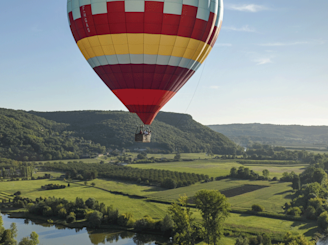Nouvelle-Aquitaine offers an enormous variety of environments and experiences: it’s rather like the Best of France condensed into a single region!
Climate
The climate of Nouvelle-Aquitaine is essentially temperate, which rather reflects its famous easy-going lifestyle. Sunshine levels are high at around 2,000 to 2,200 hours per year, which is similar to some Mediterranean regions.
Nevertheless, there are distinctions to be made between different parts of the region:
- The Aquitaine maritime climate zone includes the majority of the region, from Charentes to the Landes. Here, the mild winters and relatively hot summers are tempered by onshore breezes.
- The maritime climate of the north-west (Poitou). This area receives moderate rainfall levels, and enjoys warm summers and cold - but not freezing - winters.
- The Limousin maritime climate is subject to semi-continental influences (Limousin)
- The maritime micro-climate of the Basque Country is rather more humid (the western half of the Pyrénées-Atlantiques and south of the Landes).
- The Pyrenees have a mountain climate that varies with altitude: the Pyrenean climate.
Geography
The Nouvelle-Aquitaine region of south-western France covers a land area of 84,036 km², making it similar in size to Austria. It is France’s largest region, and is made up of twelve departments: Charente, Charente-Maritime, Corrèze, Creuse, Dordogne, Gironde, Landes, Lot-et-Garonne, Pyrénées-Atlantiques, Deux-Sèvres, Vienne and Haute-Vienne.
An infinite horizon
The Atlantic coastline of Nouvelle-Aquitaine extends for a total length of 720 kilometres. It includes an archipelago of islands, such as the Île de Ré, Île d’Oléron, Île d’Aix and Île Madame, all of which have their own distinct personality and are well worth visiting!
This varied region has a long history as a famously popular seaside destination, with the resorts of Arcachon, Biarritz and Royan, and is equally well known for its oyster farming (Marennes-Oléron and Arcachon Bay) and mussel beds (Aiguillon Bay). Oyster farming and fishing villages are integral to the unique landscapes of the region, and great places to walk as you sample the produce of the sea.
Almost all the coastline is flanked by dunes, including the most famous: the Dune du Pilat, Europe’s highest sand dune. This string of dunes is associated with a series of wetlands made up of lakes and natural aquatic reserves, such as the Hourtin Marshes, the Gironde estuary and the Poitevin Marshes.
To the south of the region, the coast remains largely wild and unspoiled. Here, only a few coastal resorts are scattered among the dunes: Soulac-sur-Mer, Carcans, Hourtin, Lacanau, Biscarrosse, Mimizan and Capbreton, and those bordering Arcachon Bay: Arcachon, Andernos-les-Bains, Lège-Cap-Ferret and Pyla-sur-Mer. This vast lagoon has been home to the Arcachon Marine Nature Reserve since 2014.
The infinite forest
Forests and woodlands are everywhere in this region, but especially in the land immediately behind the dunes: at a million hectares, the Landes Forest is the largest man-made forest in Western Europe, while the Coubre Forest covers 8,000 hectares of the region.
But the region also boasts other significant areas of continuous upland forest, including the Iraty Forest in the Basque Country, and the Double Forest in the Dordogne, which has around 500 lakes and ponds within it. Further north, around Poitiers, the Moulière Forest extends over an area of approximately 6,800 hectares. To the east, near Guéret, the Forest of Chabrières covers around 2,000 hectares.
Mountain ranges to (re)discover
The extreme south of the region is distinctive for the mountainous landscapes of the Pyrenees mountain range. While its western section consists of lush green hills, such as La Rhune, the region around Pau has a much more rocky landscape, with high peaks often above 2,000 metres: the Pic Palas (2,974 m), the Pic du Midi d'Ossau (2,884 m), the Pic d’Arriel (2,824 m), the Pic de Ger (2,613 m), the Pic d'Anie (2,504 m) to name just a few.
This rugged region is dissected by many fast-flowing mountain rivers, known as gaves (the Gave de Pau, the Gave de Bious, the Gave d'Ossau, etc.)
The Ossau Valley, one of the three great valleys of the Béarn, runs from Pau to the French border with Spain. Its glacial lakes and exceptional wildlife are protected as part of the Pyrenees National Park.
Attached to the Massif Central, the Limousin has a distinctive landscape of high wooded plateaus above lush green valleys and forests of oak and chestnut. Of all these remarkable valleys, the steep-sided valleys of the Vienne, the Isle, the Vézère and the picturesque Corrèze are not be missed.
The mountains of the Limousin are a series of small ranges (the Fayat, Monédières and Châlus Hills and Mont Bessou). Further north, the Monts de la Marche, which divide into the Guéret, Ambazac and Blond ranges are effectively wooded hills interspersed by flatlands.
The charms of the inland landscapes
The northern part of the region is structured around agricultural and winegrowing areas fed with water by more shallow valleys bordered by oak woodlands. A little further south, the open landscapes of the Niortais are largely given over to cereal crops, but also feature richly diverse wetlands, such as the Poitevin Marshes - aka Green Venice - much of which falls inside the Poitevin Marshes Regional Nature Reserve created in 1979, and now part of the Grand Sites de France network.
The Angoumois forms a transitional space between the coastal plain and the Limousin plateau. Through its landscape of low hills flows the River Charente, which passes through the cities of Angoulême, Cognac and Jarnac. This superb wine-growing region is world-famous for its Cognac and Pineau des Charentes.
At the extremity of the Angoumois, the varied landscapes of the Dordogne include woodlands (Périgord Vert), large fields of cereal crops (Périgord Blanc), oak woodlands, walnut trees and truffle woods (Périgord Noir around Sarlat-la-Canéda), and the vineyards (Périgord Pourpre towards Bergerac) that produce the world-famous wines of Bergerac, Monbazillac and Pécharmant.
The Gironde estuary : a world apart
The Gironde estuary is very much its own world. The largest unspoiled estuary in Europe and a Natural Marine Nature Reserve, it is bordered by extensive marshland known as ‘the Little Camargue’ and the hillsides where most of the great wines of Bordeaux are produced: Pauillac, Margaux, Saint-Estèphe, Saint-Julien, etc.
At its extremity is the Entre-deux-Mers (referring to its located between the rivers Dordogne and Garonne) vineyard famous for its dry and sweet white wines: Cadillac, Loupiac, Sainte-Croix-Du-Mont, etc.
On the other bank, the Libournais vineyard lies to the north (Pomerol, Saint-Émilion and Fronsac), with Graves (Pessac-Léognan) and Sauternes (Sauternes and Barsac) to the south.
The international reputation of Bordeaux wines has historically been the basis for the region’s worldwide reputation. Its wines are exported and highly rated all over the world.
The Landes de Gascognes : a world of thermal springs
To the south of Bordeaux, between the Atlantic coast and the left bank of the Garonne, the flat expanse of the Landes de Gascogne extends as far as the foothills of the Pyrenees, and contains the Landes Forest and large areas of land given over to cereals production. The region is also home to the internationally famous spa resort of Dax.
The Lot and Garonne valleys : home of the finest produce
Lot-et-Garonne is all about agriculture: Agen is famous for its prunes, Marmande for its tomatoes, tobacco, strawberries and wine (Côtes-du-Marmandais, Côtes de Duras, Buzet and Côtes du Brulhois).
But the real celebrity here is Armagnac, which is exported all over the world. It is also the home of another regional speciality: the regional fortified aperitif wine known as Floc de Gascogne.
The Basque Country and the Béarn : loyal to tradition
The extreme south of the region is home to two strong local identities: the Basque Country and the Béarn.
The green hills of the Basque Country are interspersed with historic towns and cities, such as Bayonne and Saint-Jean-Pied-de-Port. On the coast, the area boasts a series of famous prestige resorts, including Biarritz and Saint-Jean-de-Luz. Inland, it is very much a rural landscape with vineyards that produce the wines of Irouléguy, but there is also a strong livestock farming tradition here: Bayonne Ham received Protected Geographical Indication status in 1998, and Ossau Iraty sheep’s milk cheese has been an AOC protected product since 1980, and AOP protected at European level since 1996.
The area also produces traditional liqueurs, such as Izarra and Patxaran.
Very much in the heart of the Pyrenees, the hills of the Béarn are distinctly separated by a series of valleys, including the Aspe, Barétous and Ossau. Agriculture and viticulture predominate here, and the area produces the wines of Jurançon and Madiran.
Béarn is also where you’ll find the region’s main winter sports resorts of Artouste, Gourette, Issarbe, La Pierre Saint-Martin and Le Somport.





